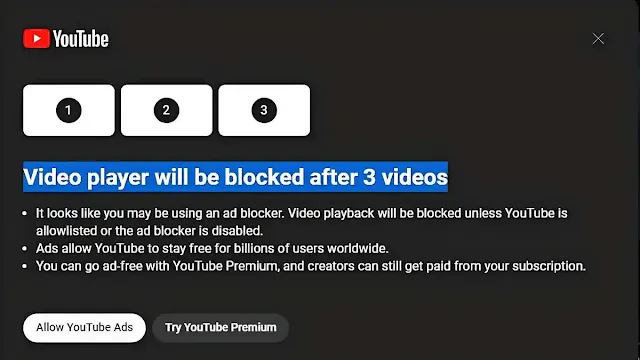YouTube to Disable Video Playback for Ad Blocker Users
In its ongoing battle against ad-blockers,
YouTube
is intensifying its efforts to persuade users to either allow ads or explore
YouTube Premium.
The platform has initiated a global campaign with the goal of promoting a
fairer ecosystem for content creators and ensuring the sustainability of the
platform.
In this article, we will delve into YouTube's recent actions, its
motivation, and the potential implications of this crackdown on ad-blockers.
Let's explore the developments and changes made by YouTube to address this
issue.
YouTube's Battle Against Ad Blockers:
As the world's leading video-sharing platform, YouTube has always relied on advertising revenue to support the vast community of content creators and provide free access to countless hours of video content for its users.
The use of ad blockers undermines this ecosystem and has been a persistent
concern for the platform. To counter this, YouTube has taken several steps
to encourage users to engage with ads or consider subscribing to YouTube
Premium.
1. Encouraging Ad Viewing:
One of YouTube's strategies to address the issue of ad-blockers is to display a notice to users when they encounter ad-blockers. This notice informs users that "Video playback is blocked unless YouTube is allowlisted or the ad blocker is disabled."
In addition, users are prompted to either allow ads or explore the benefits
of YouTube Premium. This is a direct approach aimed at making users aware of
the consequences of using ad-blockers and offering them an alternative in
the form of a premium, ad-free experience.
2. A Global Campaign:
Initially, YouTube described its efforts as a "small experiment" on a global scale. However, due to an increase in user reports over the past few weeks, YouTube decided to expand this campaign.
The expansion of this initiative underscores YouTube's commitment to
maintaining a fair and sustainable platform for content creators. By
addressing ad-blocker usage globally, YouTube is sending a clear message
that this is an issue they take seriously.
3. Terms of Service Enforcement:
Christopher Lawton, YouTube's communications manager, emphasized that the use of ad blockers goes against the platform's terms of service. By using ad-blockers, users violate the guidelines set by YouTube, which were put in place to create a level playing field for content creators.
These guidelines are aimed at fostering a diverse community of creators
globally and enabling billions of users to access their favorite content on
YouTube.
4. Changes in Ad Operations:
YouTube has made significant changes to its ad operations this year to improve the ad viewing experience for users. In May, the platform introduced unskippable 30-second ads to its TV app.
While this move was met with mixed reactions, it was a part of YouTube's
strategy to encourage users to engage with ads. Furthermore, YouTube has
been experimenting with longer but less frequent ad breaks on TV, aiming to
strike a balance between ad revenue and user experience.
5. The Future of YouTube's Anti-Ad Blocker Stance:
YouTube's determination to combat ad-blockers and other ad-disabling methods is evident. The platform is actively exploring more aggressive measures to tackle this issue in the future.
This suggests that YouTube is committed to creating a sustainable ecosystem
for content creators, where ad revenue plays a crucial role.
Implications for Users:
YouTube's crackdown on ad-blockers has raised several questions and concerns among its user base. Some users have expressed reservations about the impact of these changes on their viewing experience.
To address these concerns, YouTube is encouraging users to consider
subscribing to YouTube Premium. However, the discontinuation of the cheaper
Premium Lite plan might make this option less appealing to
users.
YouTube's commitment to providing an ad-free experience to Premium
subscribers suggests that it is banking on this premium service as a viable
alternative to ad-blocker users.
Verdict:
YouTube's global campaign against ad-blockers is a clear indication of the platform's determination to maintain a sustainable environment for content creators.
By enforcing its terms of service and encouraging users to engage with ads
or consider YouTube Premium, YouTube is striving to balance the needs of its
users with the interests of content creators.
While this approach may face resistance from some users, YouTube's
commitment to finding a solution to the ad-blocker issue is evident. The
platform's future plans to employ even more aggressive measures indicate
that it is not backing down from this battle.
Ultimately, the goal is to ensure the continued success of YouTube as a
platform for content creation and enjoyment.
